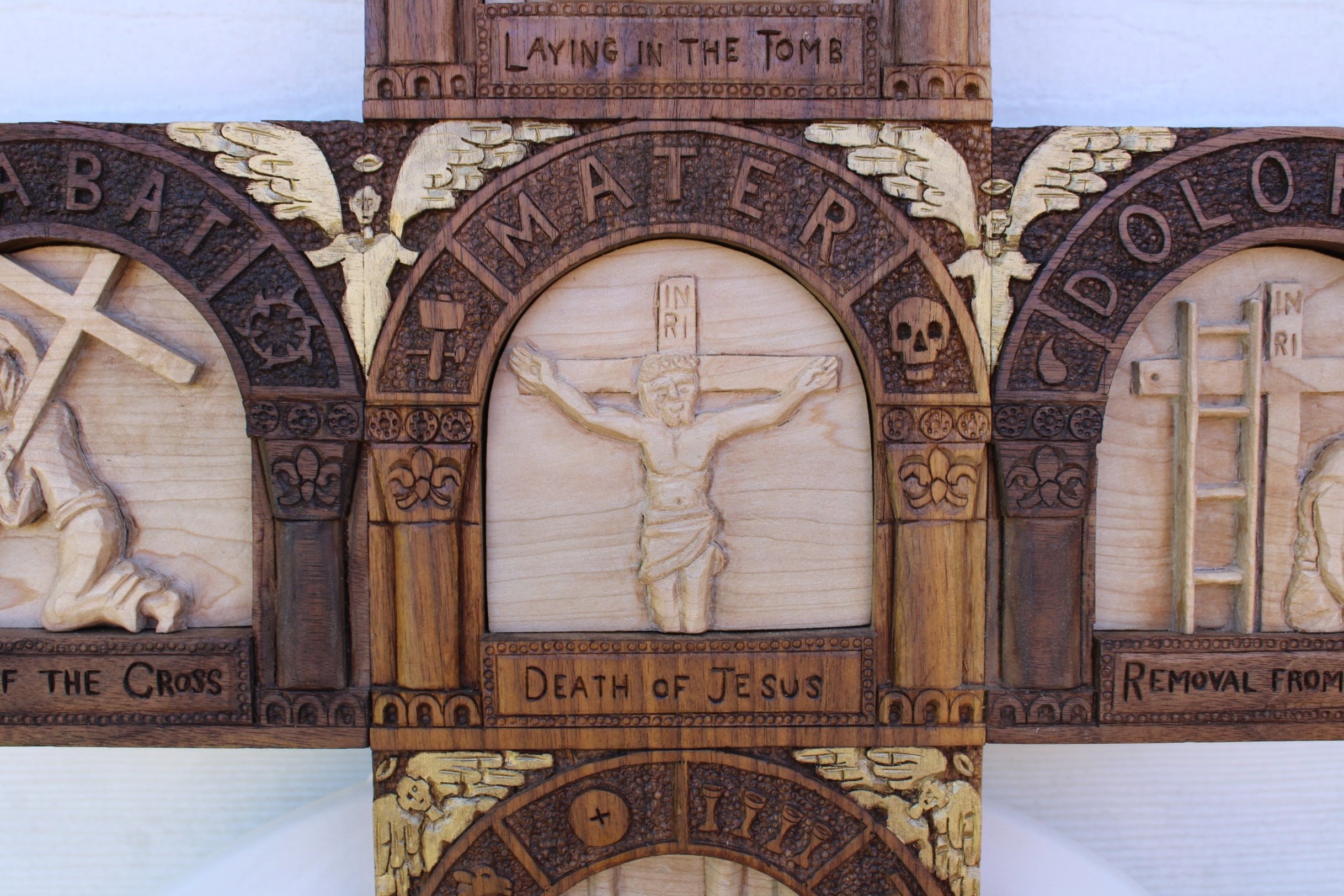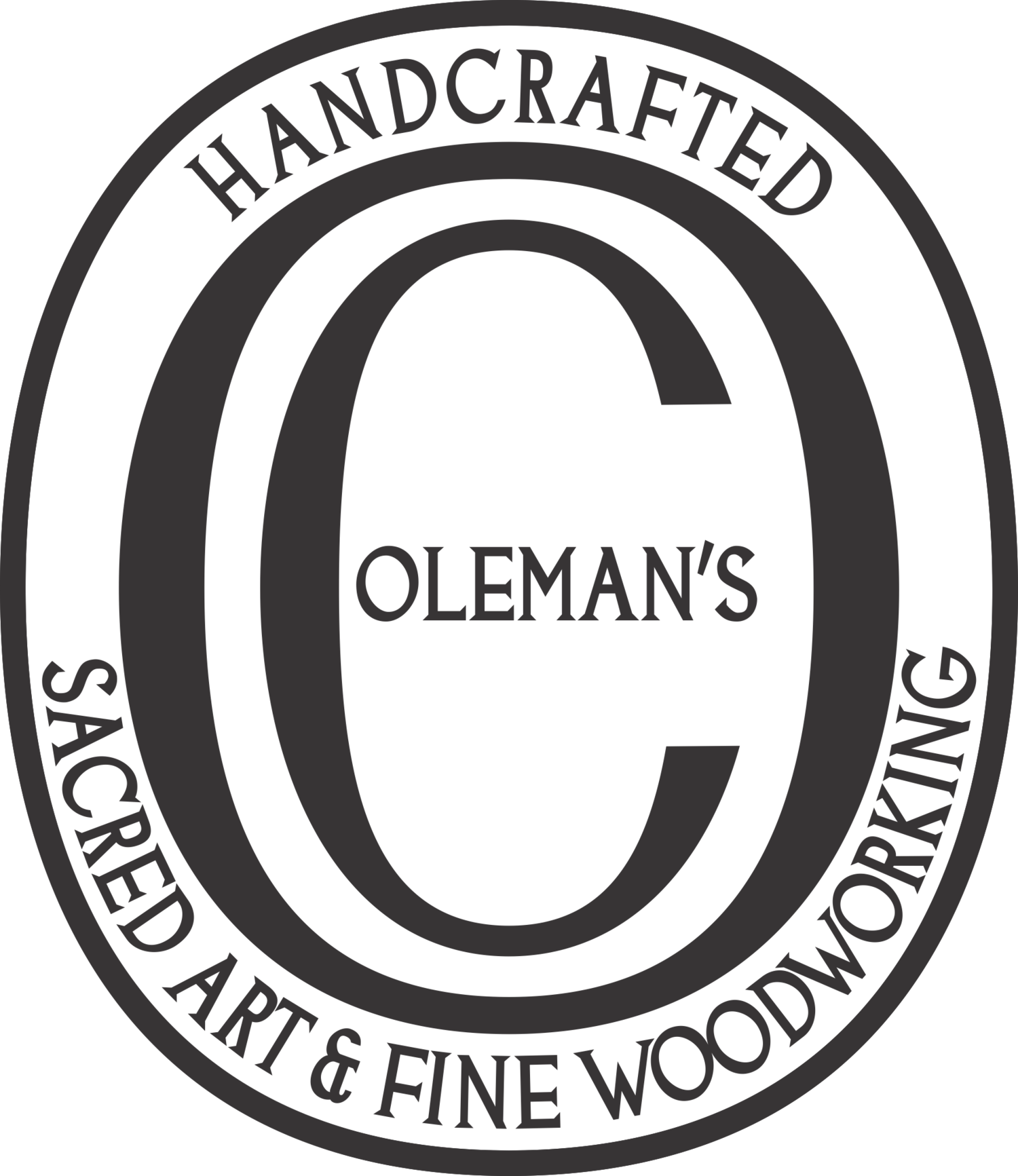
Seven Sorrows Cross
February 2021 - November 2021
The 'Seven Sorrows Cross' details each of the Seven Sorrows of Mary, a devotion made widespread through St. Bridget. The maple insets display images to aid in meditation of each Sorrow, specifically from Our Lady's point of view, which is why Mary herself is not featured in any of the panels.
The bottom endcap of the cross is the Sorrowful Heart of Our Lady pierced with seven swords. The middle of the heart is a fleur-de-lis, a lily, a symbol of Mary and her purity, and from the top of her heart bursts the fire of her love. The gold accents the swords, reminding us as we begin meditation to focus on Mary's pain and suffering.
The First Sorrow of Mary is the Prophecy of Simeon. Mary and Joseph consecrated the first-born according to the Law of Moses, bringing Jesus to the temple. There, a holy man named Simeon was praying and waiting for the Messiah, for the Holy Spirit had promised him that "he should not see death before he had seen the Christ of the Lord" (Luke 2:26). Simeon then proclaimed what we now call the Nunc Dimittis, glorifying God and then prophesying to Mary the suffering that awaited her and her Divine Son. In this panel, Simeon is holding the Child Jesus, who is raising his fingers in a sign of blessing.
The walnut frame around the panel features five motifs central to this Sorrow and to what Simeon said to Mary:
1. A pair of turtledoves that the Holy Family offered according to the law of the Lord (Luke 2:24).
2. A star, "A light to the revelation of the Gentiles..." (Luke 2:32).
3. A king's crown, "...and the glory of thy people Israel" (Luke 2:32).
4. A pierced heart, "And thine own soul a sword shall pierce" (Luke 2:35).
5. The hill of Calvary, "a sign which shall be contradicted" (Luke 2:34).
After the wise men adored the Christ Child, they were warned in a dream not to return to Herod, for Herod desired the destruction of any threat to his rule. Joseph, too, was warned in his sleep by an angel of the Lord, and the Holy Family thereupon fled to a foreign land, while Herod ordered the all the boys up to two years old in Bethlehem and its environs to be slain.
The mapel panel depicts St. Joseph holding the Christ Child and a lantern, indicating the need to travel by stealth during the night to avoid discovery. The journey from Bethlehem to Egypt was considerable, taking about 30 days on foot through rough and dangerous terrain. The Holy Family was vulnerable to the forces of nature, wild animals, and highway men. Once in the pagan land of Egpyt, they were isolated, poor, and exiled, unable to return home.
The walnut frame illustrates five symbols related to this Sorrow of Mary:
1. The angel coming to Joseph in a dream - "Arise, and take the child and his mother, and fly into Egpyt: and be there until I shall tell thee. For it will come to pass that Herod will see the child to destroy him" (Mt 2:13).
2. The moon and star - "[Joseph] arose, and took the child and his mother by night, and retired into Egypt" (Mt 2:14).
3. A slain baby - "Then Herod, perceiving that he was deluded by the wise men, was exceeding angry; and sending killed all the men children that were in Bethlehem, and in the borders thereof, from two years old and under..." (Mt 2:16).
4. Rachel weeping at the well - "Then was fulfilled that which was spoken by Jeremias the prophet, saying: A voice in Rama was heard, lamentation and great mourning; Rachel bewailing her children, and would not be comforted, for they are not" (Mt 2:17-18).
5. A scarab - The scarab is a symbol for the idolatry of the Egyptians, who worshipped not the One True God, but the false gods whom Moses refuted in Exodus. Living among pagans and idolaters was a great suffering for the Blessed Mother.
Every year, the Holy Family went up to Jerusalem for the Passover, and when Jesus was twelve years old, his family went to celebrate the feast. After the fulfilling their pilgrimage, Mary and Joseph began the return journey with their caravan. Jesus, however, remained behind without their knowledge. It wasn't until the first day had ended when Mary and Joseph realized that Jesus was not in their company. They returned in haste to Jerusalem, but not until three days had passed did they find Jesus in the temple among the doctors and elders of the faith, teaching them and asking them questions.
The maple panel depicts Joseph pointing to the Sorrow above (the Cross) and to Jesus, who is in the background in the Temple among the scholars. Mary, on finding Jesus, said to Him, "Behold, your father and I have sought you sorrowing." (Lk 2:48). Jesus replied, "How is it that you sought me? Knew you not that I must be about my Father's business?" (Lk 2:49). But Mary "understood not the saying which he spoke unto them" (Lk 2:50).
The walnut frame illustrates four symbols that connect this Sorrow to the celebration of the Passover:
1. The lamb - At the first Passover, the Israelites slayed an unblemished lamb and poured its blood on their doorposts to guard themselves against the Angel of Death. (Ex 12) Jesus, the Lamb of God, foreshadowed this sacrifice of Himself while lost to His family for three days.
2. The Eucharistic Host - Jesus celebrated the Passover on the night before He suffered, breaking bread with His disciples, thus instituting the Sacrament of the Eucharist. (Lk 22:1-19) Jesus was not humanly present to His Mother during this Sorrow, but He is now with us always in the Eucharist.
3. The four cups of Passover - During the Jewish feast, four cups were drank at different points. However, Jesus withheld the fourth cup on the night of the Last Supper and did not drink it until He was on the cross, signifying the fulfillment of the New Passover by His death (Mt 27:48).
4. The Roman numeral III - The Child Jesus was found on the third day, foreshadowing the day of Resurrection (Lk 2:46).
Mary, after watching her Son grow “in wisdom and stature, and in favor with God and man”, (Lk 2:52), remained with Jesus throughout His Passion and Death. “Daughters of Jerusalem, weep not for me, but weep for yourselves, and for your children” (Lk 23:28).
The maple panel depicts Jesus, fallen, as Mary would have seen him on the road to Golgotha, and the walnut frame depicts the crowing cock (Lk 22:61) and the crown of thorns (Mt 27:29). The fourth, fifth, and sixth panels are all framed with the first words of the famous hymn ‘Stabat Mater Dolorosa.’
“At the cross her station keeping/Stood the mournful Mother weeping/Close to Jesus to the last.’
“Now there stood by the cross of Jesus his mother, and his mother’s sister, Mary the wife of Clopas, and Mary Magdalene. When Jesus therefore saw his mother, and the disciple standing by, whom he loved, he said unto his mother, ‘Woman, behold your son!’ Then he said to the disciple, ‘Behold your mother!’ And from that hour that disciple took her unto his own home” (Jn 19:26-27).
The maple panel depicts Jesus’ crucifixion, directly above the Third Sorrow of Mary: The Loss of the Child Jesus, wherein Joseph is pointing to Jesus in this panel, tying together these two events. The walnut frame depicts a hammer and nails and a skull, as Golgotha, translated into English, means “place of the skull”. (Jn 19:17) The word ‘Mater’ is a part of the phrase ‘Stabat Mater Dolorosa’ which is carved onto the arches of the fourth, fifth, and sixth panels.
“For the sins of his own nation/Saw him hang in desolation/Till his spirit forth he sent.”
“And when Jesus had cried with a loud voice, he said, ‘Father, into your hands I commend my spirit: and having said this, he gave up the spirit’” (Lk 23:46).
“The Jews therefore, because it was the preparation, that the bodies should not remain upon the cross on the sabbath day (for that sabbath day was a high day), besought Pilate that their legs might be broken, and that they might be taken away… When they came to Jesus, and saw that he was dead already, they broke not his legs: But one of the soldiers with a spear pierced his side, and immediately came there out blood and water” (Jn 19:31, 33-34).
This maple panel depicts Jesus being removed from the cross by the faithful few who remained with Him to the last. The walnut frame depicts a drop, indicating the blood which gushed forth from Jesus when he was pierced, and a ladder, by which means His body was taken down. The walnut frame also includes the final word in ‘Stabat Mater Dolorosa,’ a hymn that reflects on Mary’s sorrow as she watched her Son suffer and die.
“Holy Mother pierce me through/In my heart each wound renew/Of my Savior crucified.”
“Then took they the body of Jesus, and wound it in linen cloths with the spices, as the manner of the Jews is to bury. Now, in the place where he was crucified there was a garden; and in the garden a new sepulcher, in which was never man yet laid. There laid they Jesus therefore because of the Jews’ preparation day; for the sepulcher was near at hand” (Jn 19:40-42).
The maple panel depicts the body of Jesus lying in the tomb. This panel is intentionally sparse and unadorned, indicating the emptiness and loneliness the Mother of our Lord must have felt as she left her Son in a closed grave.
The walnut frame depicts three symbols of this Sorrow:
1. The dogwood flower – The dogwood flower grows in the shape of a cross and has red tips on the ends of the petals, reminiscent of the wounds of Christ as He hung on the cross.
2. An urn for spices – The women who remained at the Cross anointed Jesus according to Jewish burial custom. “And they returned, and prepared spices and ointments; and rested the sabbath day according to the commandment” (Lk 23:56).
3. The Roman numeral VI – The Biblical meaning of the number six is one of incompletion and imperfection, as six is just shy of seven, the number of perfection. While Jesus lay in the tomb, His work was not yet complete.
At the very top of the cross is the radiant Immaculate Heart endcap. Whereas the endcap on the bottom of the cross was the Sorrowful Heart of Mary, this heart is full of light and sweetness, symbolizing not only that in the triumph of Mary’s Immaculate Heart, but also the purification and transformation that comes from meditating upon Our Lord’s Passion, Death, and –ultimately – Resurrection.









